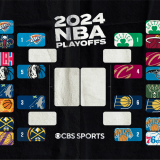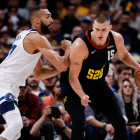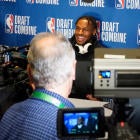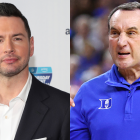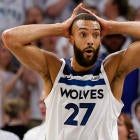The first three picks of the 2019 NBA Draft were known well in advance: Zion Williamson to the New Orleans Pelicans, Ja Morant to the Memphis Grizzlies, and RJ Barrett to the New York Knicks. After that, the fireworks started.
Here are six takeaways from a draft that could be rippling through the league, even more than your normal draft, for years to come.
1. Huge night for the Pelicans
The Anthony Davis trade keeps on giving as the Pelicans swapped the No. 4 pick, which they brought back from the Lakers, with the Hawks for picks No. 8, 17 and 35, where they took super-athletic center Jaxson Hayes out of Texas, Nickeil Alexander-Walker out of Virginia Tech and Marcos Louzada Silva of Brazil.
So now New Orleans got four first-round picks for Davis, plus the right to swap first-round picks in 2023, plus Lonzo Ball, Brandon Ingram and Josh Hart. Add Zion and Jrue Holiday to that, and New Orleans is set up with perhaps the best future in basketball while also looking like a potential playoff team right now. This is Boston all over after the Nets heist Danny Ainge pulled off in 2013.
Seriously, the athleticism and defense in this potential starting lineup is scary. Lonzo is a big-time athlete (I have no idea how there were some people who actually thought athleticism was a problem for him coming out of UCLA), and then in the front court you have Zion (who is basically the Incredible Hulk in a basketball uniform) and now potentially Hayes, who is a shot-blocking, rim-running athletic freak in his own right.
Meanwhile, Alexander-Walker, the aforementioned 17th pick, is a 6-foot-5 3-point sniper and is really smooth with the ball. The one thing the Pelicans lack right now is shooting, and he gives that to him. He was a perfect pick at that spot.
New Orleans' defense looks flat-out scary. Again, Lonzo is an elite defender at the point guard position. That is not an exaggeration. Zion could be first-team all-defense his first year. Jrue Holiday is All-Defense caliber. Hayes is a super rim protector. Ingram is the worst of the bunch, and even he's long and switchable and has gotten way better at defending against penetration.
The Pels could still use some shooting, and lord knows they have to assets to go get some.
2. Celtics in position to pounce
Boston traded the No. 24 overall pick and Aron Baynes to the Phoenix Suns. In return, Boston gets Phoenix's 2020 first-round pick, which will come via Milwaukee. So now the Celtics potentially have three first-round picks next year: Their own, the Grizzlies' No. 1 pick (which is top-six protected) and Milwaukee's first-round pick. That Memphis pick remains one of the league jewel assets and keeps Boston in position to remain a big-name trade threat.
Speaking of big names, Boston also put itself in position with this trade to potentially have max cap space when free agency starts on July 1. Baynes was set to make $5.5 million this coming season, and by not taking any money back in the deal (which they were able to do because Phoenix is under the cap and thus can absorb Baynes' money), the Celtics add that amount to their cap space, which now stands at $25 million even if they hold onto Terry Rozier. If they let Rozier walk, that number goes up to $34 million, per ESPN's Bobby Marks.
That's enough for a max free agent with less than 10 years experience, which would include all the big names on the market this summer except Kevin Durant. Boston is clearly preparing to reload with the expectation Kyrie Irving and Al Horford are not coming back, and they're in pretty good shape to do so. Even if they don't get a max player, that's a lot of money to spread out among a handful of quality players that will make a still-good and potentially very good team even better.
3. Nets inch toward two max spots
Another team that played the cap-space game on draft night, the Nets traded the 27th pick to the Clippers. This comes after trading the 17th pick to Atlanta prior to the draft. By trading out of the first round, the Nets don't have to account for the cap holds of those picks on their books -- the 27th pick they traded on Thursday is worth $1.97 million. Even that tiny bit of savings is enough to bring Brooklyn's potential total cap space to just under $69 million, per ESPN's Bobby Marks.
That's just over $2 million shy of the amount they would need to sign a 30-percent max free agent (one with less than 10 years experience) and a 35-percent max free agent (one with more than 10 years experience, which is to say Kevin Durant). To get off that final $2 million, the Nets could look at trading recently acquired Taurean Prince to a team with cap space, or perhaps Dzanan Musa and Rodions Kurucs together with a future pick attached, which would give them over $71 million in space.
To get to that number, the Nets would also have to get rid of all their free agents, including D'Angelo Russell, but they would clearly be willing to do that if it meant two max guys were coming in. If they aren't going to get two max guys, they can keep Russell and still have room for one max guy with more than $15 million left over for other free agents.
All the while, the Nets are already a playoff team.
Things are looking up in Brooklyn.
4. Seriously, what are the Suns doing?
OK, so Phoenix traded T.J. Warren and the 32nd pick to the Indiana Pacers before the draft. All they got back was a little bit of cash. The reason they did it is they wanted to get the three years and $35 million Warren has left on his contract off the books so they can be a player in free agency. The move brought Phoenix's available space to $21 million -- not enough for a max player, but enough for a few good ones.
On paper, this looks fine.
Maybe even smart.
But then the Suns come into the draft and trade with Boston for Baynes, and all told, with the 24th pick they acquired (Ty Jerome), they are back down to this:
Cap space in Phoenix now is at a projected $14M after the Boston trade to acquire Aron Baynes and the rights to Ty Jerome.
— Bobby Marks (@BobbyMarks42) June 21, 2019
Phoenix could still make more moves -- renouncing a few free agents (including Kelly Oubre Jr.), perhaps waiving and stretching Tyler Johnson's almost $20 million hit next year. But they would presumably be doing all this so they can land a high-class point guard, which has been a need of theirs for years.
Except, they could've just drafted one!
Indeed, the Suns had the No. 6 overall pick to Minnesota, which drafted Jarrett Culver, who almost everybody loved. Coby White, a super point guard some people felt was the best in the draft, went No. 7 to the Bulls. Then who do the Suns take at No. 11?
Cameron Johnson. Who many had going in the second round, or the late first round at the earliest.
If they wanted Johnson that badly, they could've traded down a lot further than No. 11 and perhaps gotten more back. Johnson likely would've been around until at least late in the first round. He's a terrific shooter, in fairness. He's 6-foot-9 and shot 45 percent from 3 last year. I had him as one of my sleepers coming into the draft, because I thought he would go too late. Nobody had any idea that he would actually end up going WAY TOO EARLY.
All told, the Suns gave up Warren (20 points a game on 42 percent from deep), and either Jarrett Culver or Coby White for a guy pretty much nobody else would've taken for another 10-15 picks. And for all of that, they have less cap space than they started with and Ty Jerome as their potential starting point guard.
I mean, maybe the Suns will make some smart roster moves and land some crazy free agent that nobody saw going there. I doubt it. This was a head-scratching night for Phoenix.
5. Hawks hit another home run
Last year, the Hawks traded the No. 3 overall pick (Luka Doncic) for the No. 5 pick, with which they took Trae Young, and Dallas' first-round pick this year, which fell at No. 10. Everybody was ready to call that a bust when Doncic came out last season like gangbusters, but by the end, Young was looking like a star in his own right and the Hawks had also added an extra lottery pick.
So coming into this year, Atlanta had six draft picks, three in the first round at Nos. 8, 10 and 17. Knowing this wasn't all that deep a draft, the Hawks this time swapped three picks for one in the other direction, swapping New Orleans' Nos. 8, 17 and 35 for the No. 4 pick, where they took De'Andre Hunter, who every scout you talk to loves. Here's what one Western Conference scout told CBS Sports about Hunter before the draft:
Scout to CBS Sports on DeAndre Hunter: "You watch the playoffs this year, and of all the guys in this draft, Hunter is one who you could picture playing at that level right now. He can make shots. He can guard twos, threes, fours. He's a pro in every way."
— Brad Botkin (@bradbotkincbs) June 21, 2019
Other scouts noted that Hunter, noted largely for his defense, is going to surprise a lot of people with his offense. One scout who spoke with CBS Sports felt Hunter was a little held back by Virginia's slow, half-court, pattern-oriented offense. Given room to roam in the NBA, Hunter can shoot from all levels and is a pretty smooth shot creator out of the post. He's really good.
Then, at No. 10, the Hawks get Cam Reddish, who was reportedly their target at No. 8. Hawks GM Travis Schlenk said Atlanta gambled that Reddish would still be there at No. 10 when they traded No. 8, and they were right. Reddish is a boom-or-bust type player, but if he booms, watch out.
"I think [Reddish] is the most talented player in the draft," an Eastern Conference scout told CBS Sports. "I really believe that."
How does arguably the most talented player in the draft fall to No. 10? Reddish has a tendency to disappear, so to speak. He can be passive. Not an alpha in terms of asserting himself. Want to know what other player gave scouts that same concern even though he had the perfect NBA body and skillset? Paul George. At least two scouts who spoke to CBS Sports, in fact, compared Reddish to George -- which, even when accounting for the fact that everyone's player comps are best-case-scenario, is pretty darn good company.
If Reddish is anywhere close to Paul George, and the Hawks got him at No. 10, to go with Hunter at No. 4, to go with what they have brewing with Trae Young and Kevin Huerter and John Collins and tons of cap space opening up next summer, man, Travis Schlenk is going to be up for a raise.
6. Potential sleepers
- Nassir Little to Portland at No. 25: Two scouts told CBS Sports that Little has "top-10 talent." There are questions about his offense and shooting, which is why a little drop would've been understandable, but on size, athleticism and projectable defense alone, the Blazers getting him at No. 25 is all reward and absolutely no risk. This could look really good in a few years.
- Bol Bol to Denver at No. 44: The son of Manute Bol, the 7-foot-2 center from Oregon was considered a lottery pick by many people. He's not just tall -- he's incredibly mobile and skilled for that size. He can shoot. He averaged over 21 points a game for Oregon in limited action before going down for the season. Indeed, injuries are a concern for anyone that size. But at No. 44? If Bol is anywhere near the player a lot of people think he can be, Denver just pulled off a crime.
- Bruno Fernando at No. 34 to Atlanta: Continuing after their first-round magic, Atlanta landed a total bruiser in the 6-10 Fernando, a gritty tough guy who offers the defense/physicality the Hawks need to offset John Collins, who is a beast offensively but not so much on defense. Suddenly the Hawks are putting together a nice balance of pizzazz and power
- Eric Paschall at No. 41 to the Warriors: It sounds strange to say, but the Warriors need shooting, and Paschall out of Villanova gives it to them. He's in the Warriors' mode as a 6-foot-7 position-less player who can play across the board in a movement-based offense and defense, and anyone who can knock down shots will be a welcomed spacer for Steph Curry, who will be playing without Kevin Durant for all of next year at least and without Klay Thompson for much of the regular season.
- Dylan Windler at No. 26 to the Cavs: Windler is one of the best shooters in the draft. He may end up being the best. A lefty, he's 6-foot-8 and shot almost 43 percent from 3 last year for Belmont (shout out Ian Clark). He also grabbed better than 10 boards a game. He's a player. He's definitely a shooter at worst. Getting him at 26 is about where he was projected, but he could out-perform that easily.









